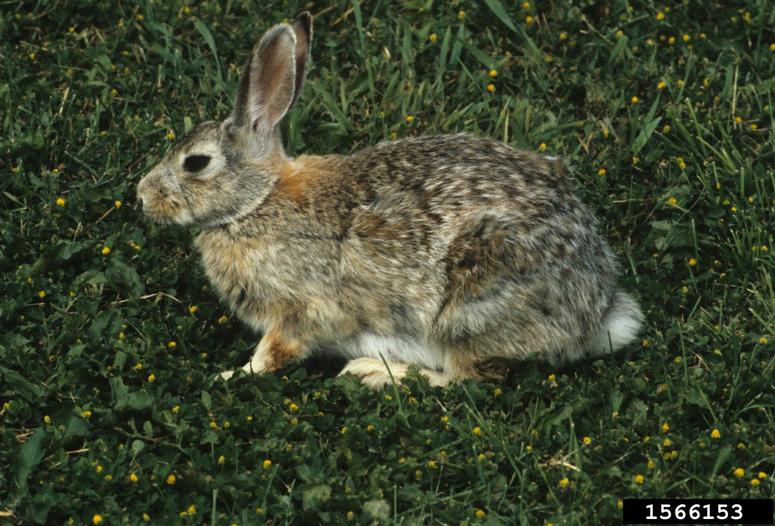 Desert Cottontail Rabbits - December 19, 2018 Jeff Schalau, Agent, Agriculture & Natural Resources University of Arizona Cooperative Extension, Yavapai County The most common species of rabbit in Arizona is the desert cottontail (Sylvilagus audubonii). They are especially plentiful in years have average abundant winter precipitation. While these garden visitors can be cute and fun to watch, they can also be destructive to tender annuals, vegetables, and newly planted trees and shrubs. There are several methods that can be employed to minimize the effects of cottontail rabbits on your favorite garden plants. Typically, cottontails live only 12 to 15 months in the wild and it is rare for them to live longer than two full years. According to the Arizona Game and Fish Department, desert cottontails may have up to five litters of two to four young per year. However, this reproductive potential is rarely reached due to predation and other environmental factors. The young leave the nest in two to three weeks. Cottontail rabbits generally spend their entire lives in an area of 10 acres or less, so if there is suitable habitat within this distance, you are likely to encounter rabbits. They are most active evenings, mornings, and at night. During cold weather, they use natural cavities and burrows of other animal for their dens. Otherwise, cottontail rabbits seek cover and protection in brush piles, brushy hedgerows, debris filled gullies, and landscaped backyards with suitable cover. Cottontails rarely drink, and free water does not appear to be a requirement for either their survival or reproduction. However, moist areas act as an attractant because of succulent vegetation. Removal and/or modification of these features will change the area's suitability as cottontail habitat. With any garden “pest”, damage must be correctly identified before control efforts can be effective. Often, cottontails are observed feeding and frolicking which makes identification much simpler. In general, cottontails eat vegetables and flowers in spring and summer and cause damage to the lower potions of woody plants in fall and winter. Rabbit damage appears as cleanly clipped stems on tender shoots and small, chiseled, gnaw marks on woody plants. Cottontails seem to prefer plants in the rose family: apples, raspberries, blackberries, etc. Vegetables and many annual flowers are also favorites. Conversely, corn, squash, tomatoes, potatoes and some peppers are rarely bothered. These general feeding guidelines are often negated in times of drought and when food options are limited. Cottontail rabbits are game species and a general hunting license is required for those 14 and older to hunt them in Arizona. In addition, firearms use is often restricted in residential areas. Persons considering using a firearm to manage cottontail rabbits must be aware of local laws and hunting regulations. The best way to prevent rabbit damage is to simply exclude them. This can be most effectively done with a two or three-foot-tall poultry wire fence with the bottom tight to the ground or buried one or two inches. The poultry wire should have holes one inch or smaller. If rabbits are digging under the poultry wire, it should be bent to a 90-degree angle on the outside edge. Gates should have a “door sweep” of rolled poultry wire to prevent them from crawling through the gaps. To protect young trees, use cylinders of ¼" wire hardware cloth (heavy duty galvanized wire screen) wrapped around the tree trunk. It should be spaced one or two inches away from the trunk, buried two inches deep, and be tall enough to extend beyond a cottontail's reach (20+ inches). Repellents are also available. These substances either render the plant parts distasteful or smell bad to rabbits. Commercially available repellents are also available and can mail ordered. The most effective rabbit repellents are made with animal blood. Hot pepper wax is often used as a taste repellent, but new growth will not be protected unless a coated with a new application. “Home remedy” repellents such as human hair and perfumed soaps are usually not effective. In vegetable and flower gardens, exclusion is the best strategy. In ornamental landscapes, selection of resistant plant species and tolerating some plant damage will lower your gardening stress level. See below for more information on cottontail rabbits and fencing designs. Follow the Backyard Gardener on Twitter – use the link on the BYG website. If you have other gardening questions, call the Master Gardener help line in the Camp Verde office at 928-554-8992 or e-mail us at verdevalleymg@gmail.com and be sure to include your name, address and phone number. Find past Backyard Gardener columns or provide feedback at the Backyard Gardener web site: http://cals.arizona.edu/yavapai/anr/hort/byg/. Photos  Desert cottontail rabbit, Sylvilagus audubonii (Alfred Viola, Northeastern University, Bugwood.org).
Desert cottontail rabbit, Sylvilagus audubonii (Alfred Viola, Northeastern University, Bugwood.org).Additional Resources Cottontail Rabbits Internet Center for Wildlife Damage Management, University of Nebraska Lincoln Note: not all management strategies shown in this resource are legal in Arizona. icwdm.org/handbook/mammals/mam_d75.pdf Rabbits and Hares Arizona-Sonora Desert Museum www.desertmuseum.org/books/nhsd_rabbits.php Catalogue of Fence Designs Australian Department of the Environment and Energy Excellent schematics of effective rabbit fencing. www.environment.gov.au/system/files/resources/b39c119e-c58a-4473-9507-db68da31a95c/files/catalogue.pdf Deer and Rabbit Resistant Plants University of Arizona Cooperative Extension extension.arizona.edu/sites/extension.arizona.edu/files/pubs/az1237.pdf |